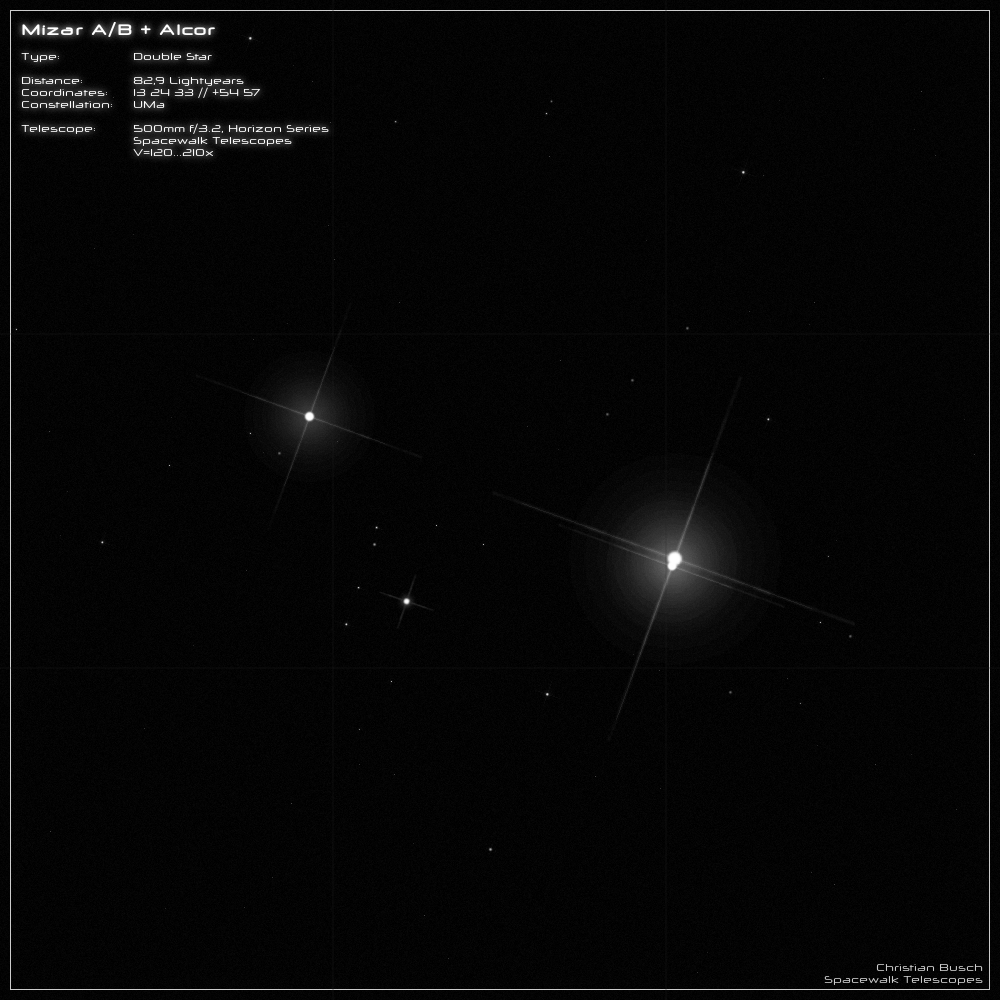Mizar and Alcor
Mizar and Alcor are two stars that are located very close to another in the constellation “Big Dipper”. Mizar is the brighter one of the two stars
and has a much fainter companion at an apparent distance of 11.8' (arcminutes): Alcor! This double star has been known for centuries as an
eye tester, as it was used to test the eyesight (farsightedness) of warriors.
1) Mizar:
Mizar itself has a brightness of 2.06mag and is located at a distance of 82.9 light-years. It is also a member of the “Ursa Major Movement
Group”. Even with a small telescope, Mizar can be split into 2 components. The companion is 14.4” arcseconds away and has a magnitude
of 3.95mag. The first observation is attributed to B. Castelli, who is believed to have first separated the star on a cold January night in 1617.
According to an exchange of letters with Galileo Galilei, he too is said to have seen the star separated just one week later. In 1722, the star
between Mizar and Alkor was mistaken for a planet.
Mizar is a quadruple star system, as the two main components A/B in turn form a double star system as well. In the case of A, the two stars
have a mass of 2.22/2.24 solar masses, a surface temperature of around 9,000 Kelvin, are 2.4x the size of our sun and shine 33x as bright.
The masses of B are 1.8/0.4 solar masses at a temperature of 8,000 Kelvin. The age of the stars is estimated at 370-500 million years - so they
are significantly younger than our sun.
2) Alcor:
Alcor is also not a single star, but a double star. The distance is a little less than to Mizar - it is 81.7 light-years.
Even today it is still not clear whether Mizar and Alkor form a binary star system or just happen to be in the same direction. With the help of
computer simulations, the distance between the two stars was determined to be 1.2 light-years, but with a very large uncertainty of 0.7 light-years.
The smallest possible distance should be 0.3 light-years, which corresponds to around 18,000 AU. In star clusters with a mass > 100 solar masses,
binary star systems are disturbed by other stars to such an extent, that orbital radii of more than 10,000 AU do not actually occur or are unstable.
So it could well be that Mizar and Alkor once belonged together, but no longer do. New insights can certainly be gained with the help of GAIA.
----------------------------------------------------------------------------------------------------------------------------------------------
In my 20” f/3 telescope, Mizar offers a wonderful sight at a magnification of 120x. The bright glow of the 2mag bright main star is simply stunning
and the split is of course super easy.
In the drawing I have tried to show the surrounding stars as they were visible at a magnification of 120x. At higher magnifications, many more stars
would have been visible, but then the double star would have had very little space in the field of view and I didn't like that.
Just outside the field of view, I was able to observe a tiny galaxy on the extension line of Mizar/Alkor at 370x. :) Unfortunately, it is not included
in the drawing.

